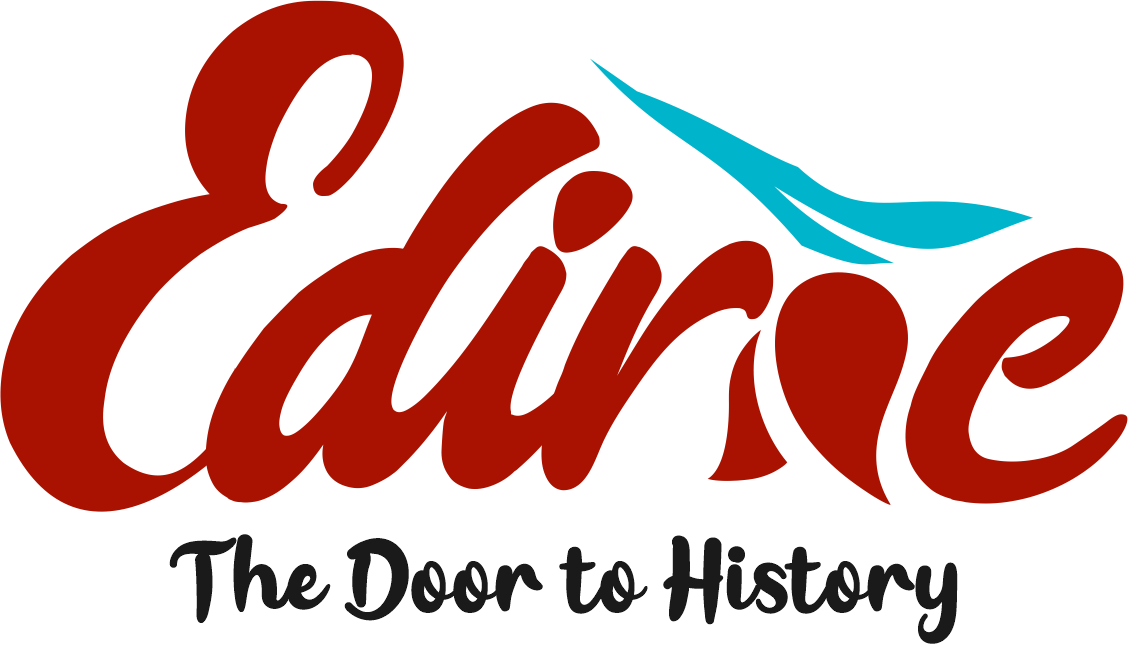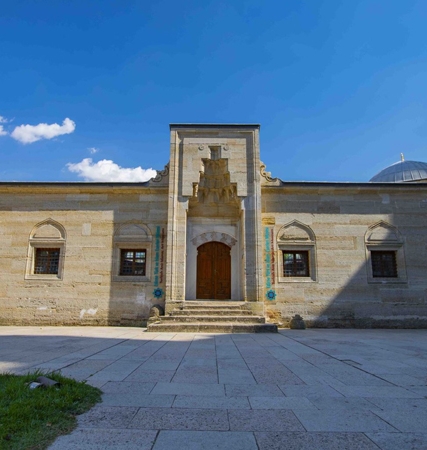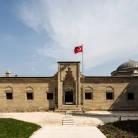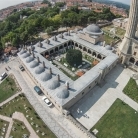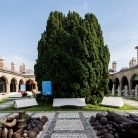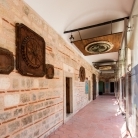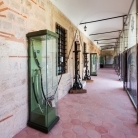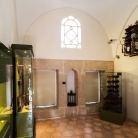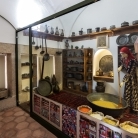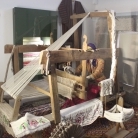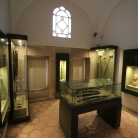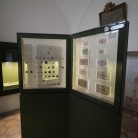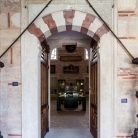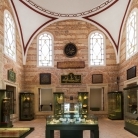Museum of Turkish Islamic Art
The first museum in Edirne was established by Dr Rıfat Osman, Arif Dağdeviren and Necmi İğe in 1925 in the Dar-ül Hadith Madrasah, which is part of the Selimiye Complex, by the order of Mustafa Kemal. The museum was called the Archaeological Museum and included valuable ethnographic artefacts and tombstones. Later, when this museum could not fulfil the need, a second museum was needed. A second department under the name of Ethnography was opened on 25 November 1936, on the thirteenth anniversary of the foundation of Edirne, in the Dar-ül Kurra Madrasah, which was also part of the Selimiye Complex. The Ministry of National Education and the General Directorate of Foundations contributed financially to this museum, and the museum was reinforced with some valuable artefacts from the Ankara Ethnography Museum and the Topkapı Palace Museum. After the Second World War, most of the artefacts in the Edirne Museums were returned to the museums and the remaining ones were exhibited only in the Dar-ül Hadith Madrasah. However, the number of artefacts in the museum increased with purchases, donations and artefacts from excavations and a new museum was needed in Edirne. The new museum building, the project of which was designed by Y. Architect İhsan Kıygı, was opened on 13 June 1971 under the name of "Archaeology and Ethnography Museum". The museum in the Dar-ül Hadith Madrasah was also named "Museum of Turkish Islamic Art".
Located to the south-east of Selimiye Mosque and used as a museum since 1925, the madrasah consists of a main classroom, student rooms and a courtyard with a portico. In the courtyard where the yew tree, which is a monumental tree, is located, tombstones from the 15th century and the tombstones of janissaries, of which few examples remain, are exhibited. Inscriptions from Ottoman Period buildings, a section reflecting the Ottoman water culture, and the food carts, cannons and cannonballs used in the Balkan War are also exhibited in the courtyard. There is also a resting area for visitors in the courtyard.
The visit to the museum begins with the room of respect for Mimar Sinan. In this room, where the statue of Sinan the Architect is located, the mural depicting the Kaaba, pencil work and plaster decoration samples taken during the repair of the Selimiye Mosque Manuscripts Library are exhibited.
The Ottoman Civilization, which made very important contributions to the development of the art of calligraphy, produced rich works in this field in every respect. Among the works exhibited are examples of calligraphy of various styles and periods applied on stone, wood, glass, leather and paper. The oldest of these plates belongs to the famous calligrapher Sheikh Hamdullah. Writing sets consisting of various writing instruments are also on display.
In the Cutting-Piercing Weapon Room, 18th and 19th century swords, yatagans, wedges, maces, shashpers, tebers and Edirnekari bows are exhibited. In the Weapon Room 2, flintlock rifles adorned with precious stones from the 17th and 18th centuries, coral inlaid, gold and silver plated flintlock pistols are exhibited. In the Gazâ Room, there is a photograph of Şükrü Pasha, the defender of Edirne during the Balkan War, the bloody banner used by the 174th Regiment, which symbolizes the liberation of Edirne, and selected examples of insignia and medals.
In the Glass-Leatherware Room, there are examples of glass, crystal and crystal jugs, fountains, vases, vases, gülabdan, lamps, candlesticks, lanterns and oil lamps. In addition to these, leather artifacts consisting of bags, saddlebags and weapon holders used by the Surre Regiment's commanders are also included in the exhibition. Wooden Artifacts Examples of architectural wooden ornaments, wooden objects and tools used in daily life, candlestick bases and rub'u boards made with the interlocking technique are in this room.
The coffee set made of carnations and the carnation-covered zemzem holders are noteworthy artifacts. The artifacts in the Tile Room are mostly Edirne Palace and Şahmelek Pasha Mosque and Selimiye Mosque tiles. There are examples of Kütahya and Iznik tiles from the 15th, 16th and 17th centuries.
In addition to these, there are also ceramic plates obtained from palace excavations. In the Saray-ı Cedit Room, 17th century wall tiles, ceramic plates and engravings of the New Palace of Edirne are exhibited in this room. In the Clothing Room, women's clothes and jewelry specific to the Balkans are exhibited. In the Circumcision Room, the circumcision ceremony, which has an important place in Turkish tradition, is reenacted. Atlas embroidered bedding created by bringing together bindallı bundles, clothes and jewelry on mannequins and rugs are exhibited. Weavers' Room In addition to the tools used in the transformation of cotton, wool or silk into fabric, the oldest weaving loom in Thrace, donated to the museum by the Yaveroğlu family from Edirne, is exhibited.
The Saddler and Shoemaker's Room contains shoemaker and saddler's looms, tools and samples. A saddler's shop from Saraçlar Street, whose only name has survived to the present day, is recreated. The large shoe mold that once hung on the prayer dome of the Kavaflar Bazaar can also be seen here. In the Kitchen Utensils Room, braziers, pots, samovars, lanterns and coffee sets from the Matbah-ı Âmire kitchen utensils are exhibited. The Kırkpınar Room has an interesting arrangement with photographs of famous wrestlers who have won the title of chief wrestler in Kırkpınar, the Kırkpınar Agha mannequin and the Kırkpınar hologram where two pehlivas hold a peshrev. In the galleries, inscriptions of various buildings, wooden ceiling cores of Edirne houses from the end of the 19th century, lantern samples, Beyazıt Complex kündekari door wings, 18th century ceremonial shields, swords, spears and cast candlesticks are exhibited in the porticoes.
In the Dervish Lodges Room, various items given to community centers after the closure of dervish lodges and lodges are exhibited. On the walls are manuscript plates from various tekkes. In the glass and niche showcases, there are photographs of the Edirne Muradiye Mevlevihane, the prayer rug of the last sheikh Ahmet Selahattin Efendi, bazaarman's tongs, Mevlevi coins, kudums, qudums, ney, rebab, keşkül, healing bowls, teberler, chain maces, manuscript Qurans from the 15th and 19th centuries, and prayer books. In front of the mihrab is the prayer rug of the Edirne Old Mosque and on both sides of the mihrab are candles made in the candle house of the Sultan Beyazit II Complex.
The museum serves under the Ministry of Culture and Tourism.
Address : Meydan Mahallesi, Taş Odalar Sokak, No:4.
Telephone : (0284) 225 16 25
E Mail : edirnemuzesi@ktb.gov.tr
Visiting Days : Open to Visitors 7 Days a Week.
Visiting Hours : Summer (April 1-September 30) 09.00-19.00
: Winter (October 1-March 31) 09.00-17.30
Fee : Paid (under 18 and over 65 free of charge)
MuseumCard : Valid.

